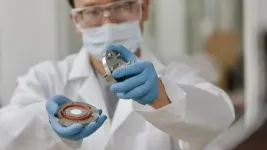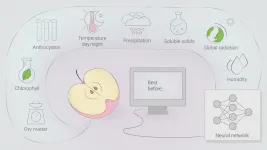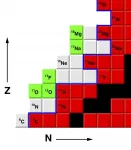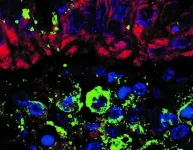Sounds like home: Murrelets choose breeding locations by eavesdropping on other murrelets
2021-03-30
(Press-News.org) CORVALLIS, Ore. - Oregon State University researchers broadcast marbled murrelet calls in mature forests and found that the threatened seabirds' choice of breeding locations is strongly influenced by whether they hear other murrelets in the area.
The research by scientists in the OSU College of Forestry and College of Agricultural Sciences is important because the elusive seabird's populations are in decline and recovery may be hindered by there being too few birds around to provide information to each other about where to nest.
Findings were published in Ornithology, the the flagship journal of the American Ornithologists Union.
"The odds that marbled murrelets would consider nesting at sites where we broadcast murrelet calls were many times greater than at sites where we didn't," said lead author Jonathon Valente, a postdoctoral researcher with the College of Forestry's Oregon Marbled Murrelet Project.
Marbled murrelets are closely related to puffins and murres but unlike those birds, murrelets raise their young as far as 60 miles inland in mature and old-growth forests.
"There aren't many species like it," said study co-author Jim Rivers, also a faculty member in the College of Forestry. "In fact, there's no other bird that feeds in the ocean and commutes such long distances to inland nest sites. This behavior is really unusual and it makes this species especially challenging to study."
In 2016, Valente, Rivers and three collaborators at Oregon State simulated the presence of murrelets at 14 randomly selected potential breeding sites by broadcasting the bird's calls during breeding season. Between the rounds of simulations, they recorded wild murrelet calls at the sites and compared call rates with rates at 14 control sites where no recorded were broadcast.
In the year of the broadcast experiment, simulated murrelet calls increased the odds of recording wild murrelet calls by as much as 15 times. The scientists hypothesized that these were young "prospecting" birds, on the lookout for new nesting sites.
To the researchers' surprise, these prospectors appeared to have remembered the locations of experimental areas the following breeding season, nearly a year after broadcasts of murrelet calls had ceased. The odds of a site being occupied during the 2017 breeding season were 10 times greater at the experimental sites than the control sites.
"That means it would likely be a good idea for conservation managers to consider broadcasting vocalizations to encourage murrelets to nest in unused, high-quality habitat," said co-author Matt Betts of the College of Forestry. "And because murrelets are attracted to other murrelets, protecting areas adjacent to known nesting sites may also be an effective conservation approach."
The dove-sized marbled murrelet spends most of its time in coastal waters eating krill, other invertebrates and forage fish such as herring, anchovies, smelt and capelin. Murrelets can only produce one offspring per year, if the nest is successful, and their young require forage fish for proper growth and development.
The secretive birds typically lay their single egg high in a tree on a horizontal limb at least 4 inches in diameter. Steller's jays, crows and ravens are the main predators of murrelet nests.
Along the West Coast, marbled murrelets are found regularly from Santa Cruz, California, north to the Aleutian Islands. The species is listed as threatened under the U.S. Endangered Species Act in Washington, Oregon and California.
INFORMATION:
Also collaborating on the vocalization study were Kim Nelson and Dan Roby of the OSU College of Agricultural Sciences. The College of Forestry and the USDA National Institute of Food and Agriculture supported this research.
[Attachments] See images for this press release:
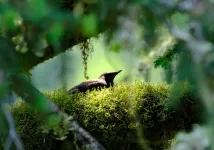
ELSE PRESS RELEASES FROM THIS DATE:
2021-03-30
On sultry summer afternoons, heating, ventilation and air conditioning (HVAC) systems provide much-needed relief from the harsh heat and humidity. These systems, which often come with dehumidifiers, are currently not energy efficient, guzzling around 76% of the electricity in commercial and residential buildings.
In a new study, Texas A&M University researchers have described an organic material, called polyimides, that uses less energy to dry air. Furthermore, the researchers said polyimide-based dehumidifiers can bring down the price of HVAC systems, which currently cost thousands of dollars.
"In this study, we took an existing and rather robust polymer and then improved its dehumidification efficiency," said Hae-Kwon Jeong, McFerrin Professor in the Artie McFerrin ...
2021-03-30
Since early in the COVID-19 pandemic, parents, teachers, and school administrators have faced difficult questions regarding when and how to safely reopen for in-person learning. During the 2020-2021 fall semester, school districts around the United States navigated their reopening plans -- many opting for exclusively online learning or hybrid models -- with little data on how SARS-CoV-2 spreads among children or how in-person learning would impact transmission in the schools' communities. A new study in The Journal of School Health joins a growing body of evidence that, with appropriate measures, there are ways for schools to safely reopen.
In this study, scientists analyzed data from two large, independent k-12 schools that re-opened for in-person learning ...
2021-03-30
WASHINGTON--A vast global ocean may have covered early Earth during the early Archean eon, 4 to 3.2 billion years ago, a side effect of having a hotter mantle than today, according to new research.
The new findings challenge earlier assumptions that the size of the Earth's global ocean has remained constant over time and offer clues to how its size may have changed throughout geologic time, according to the study's authors.
Most of Earth's surface water exists in the oceans. But there is a second reservoir of water deep in Earth's interior, in the form of hydrogen and oxygen attached to minerals in the mantle.
A new study in AGU Advances, which publishes high-impact, open-access research and commentary across the Earth and space sciences, estimates how much water ...
2021-03-30
A researcher from Skoltech and his German colleagues have developed a neural network-based classification algorithm that can use data from an apple orchard to predict how well apples will fare in long-term storage. The paper was published in Computers and Electronics in Agriculture.
Before the fruit and vegetables we all like end up on our tables, they have to be stored for quite some time, and during this time they can develop physiological disorders such as flesh browning or superficial scald (brown or black patches on the skin of the fruit). These disorders contribute to the loss of a substantial amount ...
2021-03-30
Some 8,300 million metric tons of plastics have been manufactured since production exploded in the 1950s, with more than 75 percent ending up as waste and 15 million metric tons reaching oceans every year. Plastic waste fragments into increasingly smaller but environmentally persistent "microplastics," with potentially harmful effects on the health of people, wildlife and ecosystems. A new collection, "Confronting Plastic Pollution to Protect Environmental and Public Health," is publishing on March 30th, 2021 in the open access journal PLOS Biology that addresses critical scientific challenges in understanding the impacts of microplastics.
The collection features three evidence-based commentaries from ecotoxicology and environmental health ...
2021-03-30
RESTON, Va. - Greater sage-grouse populations have declined significantly over the last six decades, with an 80% rangewide decline since 1965 and a nearly 40% decline since 2002, according to a new report by the U.S. Geological Survey. Although the overall trend clearly shows continued population declines over the entire range of the species, rates of change do vary regionally.
The report represents the most comprehensive analysis of greater sage-grouse population trends ever produced and lays out a monitoring framework to assess those trends moving forward. The study can also be used to evaluate the effectiveness of greater sage-grouse conservation efforts and analyze factors that contribute to habitat loss and population change -- all critical ...
2021-03-30
(Philadelphia, PA) - The human heart works under high demand, constantly pumping oxygen-rich blood through the body. When faced with disease, however, fulfilling this demand can become increasingly difficult and harmful. In the case of chronic high blood pressure - a leading cardiovascular disease in the United States - the heart continuously overexerts, resulting in maladaptive growth and, ultimately, severe dysfunction of the heart muscle itself.
Maladaptive growth of the heart, known as cardiac hypertrophy, is brought about in part by activation of G protein-coupled kinase ...
2021-03-30
Researchers at Washington University in St. Louis reported the first observations of a new form of fluorine, the isotope 13F, described in the journal Physical Review Letters.
They made their discovery as part of an experiment conducted at the National Superconducting Cyclotron Laboratory at Michigan State University (MSU).
Fluorine is the most chemically reactive element on the periodic table. Only one isotope of fluorine occurs naturally, the stable isotope 19F. The new isotope, 13F, is four neutrons removed from the proton drip line, the boundary that delimits the zone beyond which atomic nuclei decay by the emission ...
2021-03-30
CAMBRIDGE, MA -- More than just a sign of illness, mucus is a critical part of our body's defenses against disease. Every day, our bodies produce more than a liter of the slippery substance, covering a surface area of more than 400 square meters to trap and disarm microbial invaders.
Mucus is made from mucins -- proteins that are decorated with sugar molecules. Many scientists are trying to create synthetic versions of mucins in hopes of replicating their beneficial traits. In a new study, researchers from MIT have now generated synthetic mucins with a polymer backbone that more accurately mimic the structure and function of naturally occurring mucins. The team also showed that these synthetic mucins could effectively neutralize the bacterial toxin that causes cholera.
The ...
2021-03-30
A study conducted at the University of Campinas (UNICAMP) in the state of São Paulo, Brazil, shows that compounds produced by gut microbiota (bacteria and other microorganisms) during fermentation of insoluble fiber from dietary plant matter do not affect the ability of the novel coronavirus SARS-CoV-2 to enter and replicate in cells lining the intestines. However, while in vitro treatment of cells with these molecules did not significantly influence local tissue infection, it reduced the expression of a gene that plays a key role in viral cell entry and a cytokine receptor that favors inflammation.
An ...
LAST 30 PRESS RELEASES:
[Press-News.org] Sounds like home: Murrelets choose breeding locations by eavesdropping on other murrelets

